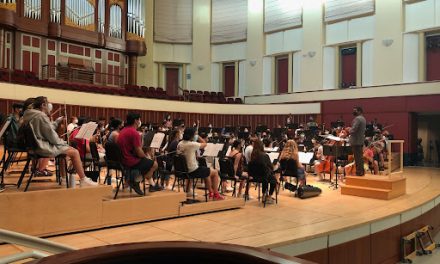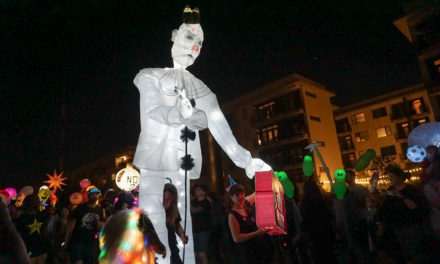Mortification of the flesh, or the act of beating oneself as a form of repentance, is a difficult subject to laugh at. It is even more difficult to rap about.
Regardless, actors in Theater Emory’s production of “Comic Mysteries (Mistero Buffo)” by Dario Fo tackled both of these obstacles last Friday. “Beat yourselves, beat yourselves, y’all!” the ensemble sang to the beat of a conga drum amidst the laughter of the full house.
“Comic Mysteries (Mistero Buffo),” written by Dario Fo in 1969, originally conceived in Italian as a one-man show, is a series of short one-act plays exploring early Christian stories. Fo is an Italian playwright, satirist and political activist who won the Nobel Prize for Literature in 1997. The version of “Comic Mysteries (Mistero Buffo)” performed last Friday, Sept. 28 at 7 p.m. was adapted into an 11-person show, translated into English by Ed Emery, the translator of various Fo works and directed by Assistant Professor, Resident Artist and Dramaturg Donald McManus of Emory’s Theater Studies department. The production ran Thursday, Sept. 27 through Saturday, Sept. 29 at 7 p.m. and Sunday, Sept 30. at 2 p.m. in the Theater Lab of the Schwartz Center for the Performing Arts. The show was sold out Thursday and Friday.
As the audience filed in on Friday night, the cast entered the stage and began warming up and interacting with the audience. Immediately noticeable was the eclectic variety of costumes the actors donned, including a fairy-angel with pink hair (College sophomore Kelly Spicer), a hippie (College sophomore Travis Daniel Draper) and an 80s disco dancer from space (College senior Madeline Teissler).
Noticing the costumes, one woman asked Oglethorpe University senior Seth Langer, who resembled a hipster lumberjack, “How weird is this going to be?” Langer responded, “As weird as you want it to be!”
His response should have been: If you’re expecting a normal show, it will be weird; if you’re expecting a weird show, it will be weird.
The show contains many absurdist elements. There is practically no fourth wall, nor is there any overarching plot. However, the audience does hear several vignettes, the most powerful of which was “Birth of the Clown,” performed by College senior Tim Harland (member of Alpha Psi Omega, the national theater honor society).
It is here, in the middle of the play, that Harland communicates the show’s message, as was told to his character, the Clown, by Jesus: “It is only with laughter that the powerful can be destroyed.” This scene fundamentally represents the original one-man show, as Harland performs solo.
The play reveals the problem of power structures throughout. In the scene that precedes Harland’s, “Birth of the Peasant,” the action breaks and Langer performs a monologue about how the bourgeoisie hijack peasant institutions and use them to oppress the lower classes. Professional Atlanta actor Brad Raymond picks up the monologue, adding, “It’s hard for us to discuss the subject of class, even harder the subject of race.” Relating the social ills of the Dark Ages to the issues we see today, professional Aldo Magnifico, in the “Introduction,” described the early critique of religious and power institutions reflected in the play as “a medieval version of the Occupy movement.”
The stage, lighting and music were all minimalistic, though not to a fault. The set and light design left much to the imagination, complementing the actors’ performances.
The music, performed by Atlanta-based actor Bryan Mercer, consisted of an African finger drum, a slide flute and four crystal bowls struck with a mallet, among other percussive instruments. Mercer set the mood well when he wasn’t parodying Pope Boniface VIII.
The show ran for almost two hours, and it was never boring.
While some of the religious messages failed to hit home with Emory audiences (clearly intended for Italians more intimately tied to Catholicism), there were plenty of other funny moments.
One such scene was Raymond and College junior Taylor Claire Kinser’s “Morality Play of the Blind Man & the Cripple,” in which two people with disabilities try to avoid Jesus to prevent themselves from being cured.
As the performance ended audience members left entertained, informed and pleased, with absolutely no desire to flagellate themselves with a whip.
– By William Hupp
The Emory Wheel was founded in 1919 and is currently the only independent, student-run newspaper of Emory University. The Wheel publishes weekly on Wednesdays during the academic year, except during University holidays and scheduled publication intermissions.
The Wheel is financially and editorially independent from the University. All of its content is generated by the Wheel’s more than 100 student staff members and contributing writers, and its printing costs are covered by profits from self-generated advertising sales.





